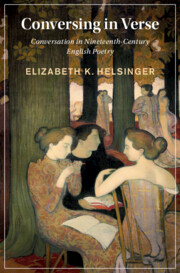Book contents
- Conversing in Verse
- Cambridge Studies in Nineteenth-Century Literature and Culture
- Conversing in Verse
- Copyright page
- Contents
- Figures
- Acknowledgments
- Chapter 1 Introduction: A Poetics of Encounter
- Chapter 2 Dialogue and the Idyll: Tennyson and Landor
- Chapter 3 Performing Conversation: Swinburne and Robert Browning
- Chapter 4 Projects of Animation: Coleridge and Clare
- Chapter 5 Ecphrastic Questions: Dante Gabriel Rossetti and Michael Field
- Chapter 6 Cruel Intimacies: Christina Rossetti and Thomas Hardy
- Epilogue
- Notes
- Bibliography
- Index
- Cambridge Studies in Nineteenth-Century Literature and Culture
Chapter 1 - Introduction: A Poetics of Encounter
Published online by Cambridge University Press: 21 July 2022
- Conversing in Verse
- Cambridge Studies in Nineteenth-Century Literature and Culture
- Conversing in Verse
- Copyright page
- Contents
- Figures
- Acknowledgments
- Chapter 1 Introduction: A Poetics of Encounter
- Chapter 2 Dialogue and the Idyll: Tennyson and Landor
- Chapter 3 Performing Conversation: Swinburne and Robert Browning
- Chapter 4 Projects of Animation: Coleridge and Clare
- Chapter 5 Ecphrastic Questions: Dante Gabriel Rossetti and Michael Field
- Chapter 6 Cruel Intimacies: Christina Rossetti and Thomas Hardy
- Epilogue
- Notes
- Bibliography
- Index
- Cambridge Studies in Nineteenth-Century Literature and Culture
Summary
Chapter 1 starts from conversation’s intimate verbal connection with verse. Conversation – a mode of social care for Victorians – inscribes not only persons but also other beings and things in figures turning together, creating a verbal way of keeping company with others that many nineteenth-century poets explored through the virtual medium of verse. Lyric written with conversation in mind is sociable, as Empson and Adorno both claimed. To create conversation in modern verse requires eliciting voice from text: both figuring voice and configuring it by prosodic means, in David Nowell Smith’s useful account, encouraging an experience of reading that expands the sense of a single, individual voice to accommodate unlike others. Conversing in verse is a way of redesigning social space, at least in a poem. The chapter turns, in its final third, to the considerable body of twentieth-century philosophical writing addressing the ethical and political importance of conversation, especially the work of Emmanuel Levinas and Maurice Blanchot as they respond to the poetry of Paul Celan.
- Type
- Chapter
- Information
- Conversing in VerseConversation in Nineteenth-Century English Poetry, pp. 1 - 21Publisher: Cambridge University PressPrint publication year: 2022

